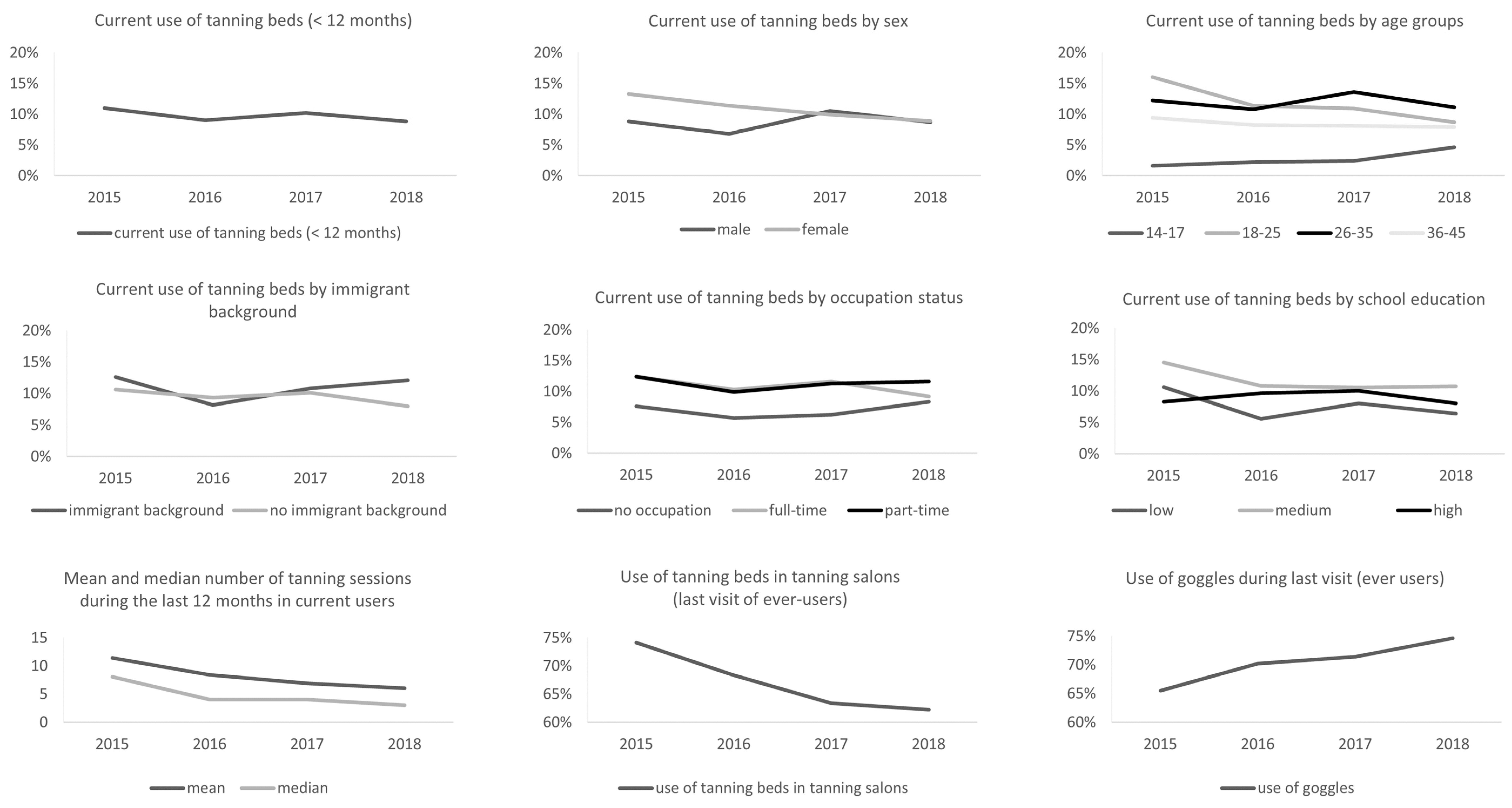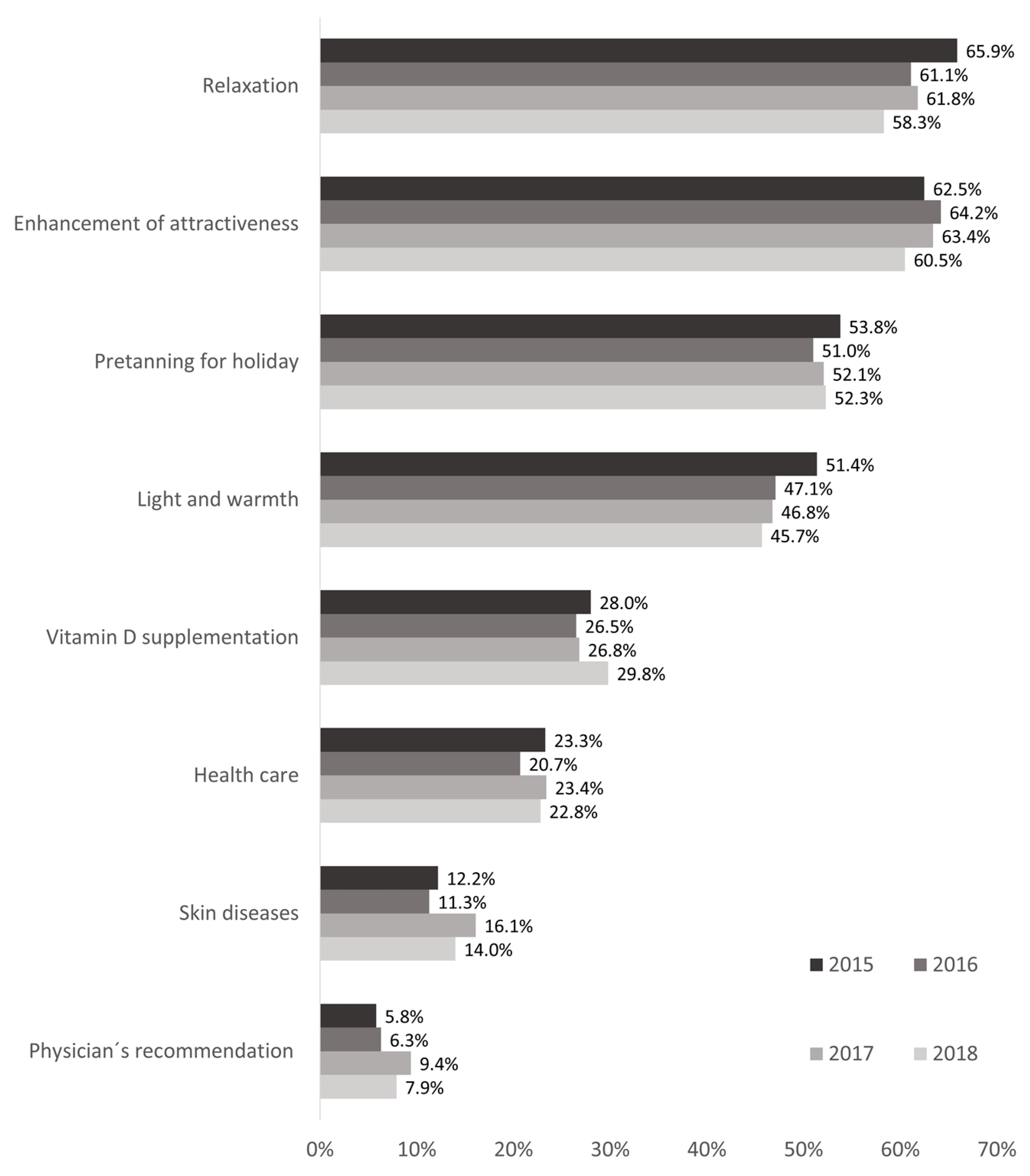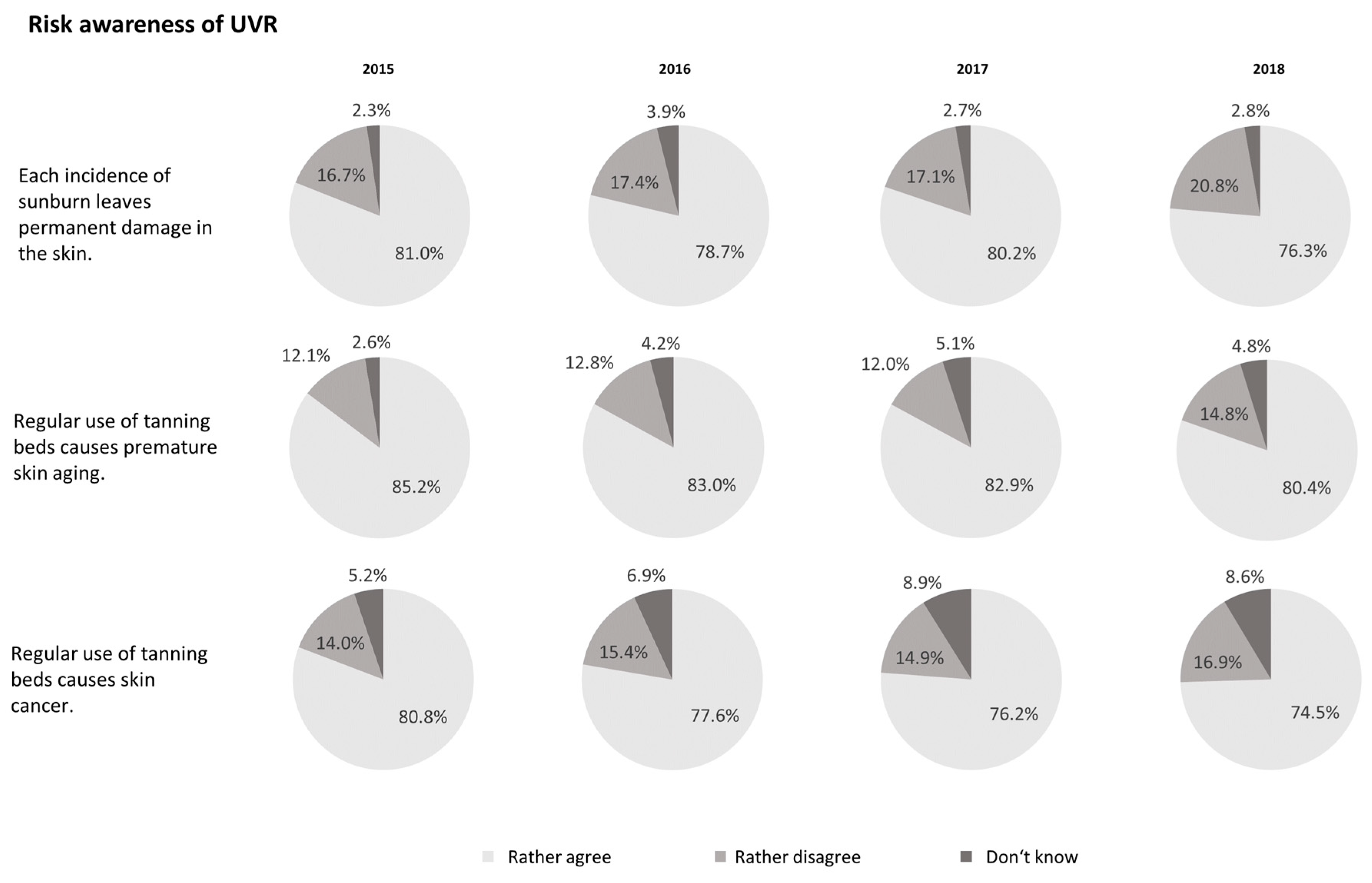Trends in Tanning Bed Use, Motivation, and Risk Awareness in Germany: Findings from Four Waves of the National Cancer Aid Monitoring (NCAM)
Abstract
1. Introduction
2. Materials and Methods
2.1. Data Collection
2.2. Measurement Tools
2.3. Statistics
3. Results
4. Discussion
4.1. Use of Tanning Beds
4.2. Reasons for Tanning Bed Use
4.3. Risk Awareness
4.4. Potential Limitations of the Study
4.5. Implications of Study Findings for Prevention
5. Conclusions
Author Contributions
Funding
Conflicts of Interest
References
- El Ghissassi, F.; Baan, R.; Straif, K.; Grosse, Y.; Secretan, B.; Bouvard, V.; Benbrahim-Tallaa, L.; Guha, N.; Freeman, C.; Galichet, L.; et al. A review of human carcinogens—Part D: Radiation. Lancet Oncol. 2009, 10, 751–752. [Google Scholar] [CrossRef]
- Boniol, M.; Autier, P.; Boyle, P.; Gandini, S. Cutaneous melanoma attributable to sunbed use: Systematic review and meta-analysis. BMJ 2012, 345, e4757. [Google Scholar] [CrossRef] [PubMed]
- Leiter, U.; Eigentler, T.; Garbe, C. Epidemiology of skin cancer. Adv. Exp. Med. Biol. 2014, 810, 120–140. [Google Scholar] [PubMed]
- Basch, C.H.; Basch, C.E.; Rajan, S.; Ruggles, K.V. Use of sunscreen and indoor tanning devices among a nationally representative sample of high school students, 2001–2011. Prev. Chronic Dis. 2014, 11, E144. [Google Scholar] [CrossRef][Green Version]
- Guy, G.P., Jr.; Berkowitz, Z.; Everett Jones, S.; Holman, D.M.; Garnett, E.; Watson, M. Trends in indoor tanning among US high school students, 2009–2013. JAMA Dermatol. 2015, 151, 448–450. [Google Scholar] [CrossRef][Green Version]
- Guy, G.P., Jr.; Berkowitz, Z.; Holman, D.M.; Hartman, A.M. Recent Changes in the Prevalence of and Factors Associated With Frequency of Indoor Tanning Among US Adults. JAMA Dermatol. 2015, 151, 1256–1259. [Google Scholar] [CrossRef][Green Version]
- Guy, G.P., Jr.; Berkowitz, Z.; Tai, E.; Holman, D.M.; Everett Jones, S.; Richardson, L.C. Indoor tanning among high school students in the United States, 2009 and 2011. JAMA Dermatol. 2014, 150, 501–511. [Google Scholar] [CrossRef]
- Miljkovic, S.V.; Jovanovic Ljeskovic, N. Sun Protection Behavior among Adolescents-a Comparative Study Conducted in 2008 and 2012. Med. Pregl. 2016, 69, 281–287. [Google Scholar] [CrossRef]
- Qin, J.; Holman, D.M.; Jones, S.E.; Berkowitz, Z.; Guy, G.P., Jr. State Indoor Tanning Laws and Prevalence of Indoor Tanning Among US High School Students, 2009–2015. Am. J. Public Health 2018, 108, 951–956. [Google Scholar] [CrossRef]
- Simmons, R.G.; Smith, K.; Balough, M.; Friedrichs, M. Decrease in Self-Reported Tanning Frequency among Utah Teens following the Passage of Utah Senate Bill 41: An Analysis of the Effects of Youth-Access Restriction Laws on Tanning Behaviors. J. Skin Cancer 2014, 2014, 839601. [Google Scholar] [CrossRef]
- Bandi, P.; Cokkinides, V.E.; Weinstock, M.A.; Ward, E. Sunburns, sun protection and indoor tanning behaviors, and attitudes regarding sun protection benefits and tan appeal among parents of U.S. adolescents-1998 compared to 2004. Pediatr. Dermatol. 2010, 27, 9–18. [Google Scholar] [CrossRef] [PubMed]
- Margolin, K.A. Indoor tanning use among U.S. youth—Can skin health behaviors be legislated? Curr. Oncol. Rep. 2010, 12, 290–291. [Google Scholar] [CrossRef] [PubMed]
- Francis, K.; Dobbinson, S.; Wakefield, M.; Girgis, A. Solarium use in Australia, recent trends and context. Aust. N. Z. J. Public Health 2010, 34, 427–430. [Google Scholar] [CrossRef] [PubMed]
- Moan, J.E.; Baturaite, Z.; Grigalavicius, M.; Juzeniene, A. Sunbed use and cutaneous melanoma in Norway. Scand. J. Public Health 2013, 41, 812–817. [Google Scholar] [CrossRef] [PubMed]
- Hansen, M.R.; Bentzen, J. High-risk sun-tanning behaviour: A quantitative study in Denmark, 2008–2011. Public Health 2014, 128, 777–783. [Google Scholar] [CrossRef]
- Koster, B.; Meyer, M.K.; Andersson, T.M.; Engholm, G.; Dalum, P. Sunbed use 2007–2015 and skin cancer projections of campaign results 2007–2040 in the Danish population: Repeated cross-sectional surveys. BMJ Open 2018, 8, e022094. [Google Scholar] [CrossRef]
- Koster, B.; Thorgaard, C.; Philip, A.; Clemmensen, H. Sunbed use and campaign initiatives in the Danish population, 2007–2009: A cross-sectional study. J. Eur. Acad. Dermatol. Venereol. 2011, 25, 1351–1355. [Google Scholar] [CrossRef]
- Cancer Research UK. Trends in Awareness and Behaviour Relating to UV and Sun Protection: 2003–2013; Cancer Research UK: London, UK, 2014. [Google Scholar]
- Schneider, S.; Gorig, T.; Schilling, L.; Breitbart, E.W.; Greinert, R.; Diehl, K. German “National Cancer Aid Monitoring” 2015–2019-study protocol and initial results. J. Dtsch. Dermatol. Ges. 2017, 15, 895–903. [Google Scholar] [CrossRef]
- Schenk, L.; Bau, A.M.; Borde, T.; Butler, J.; Lampert, T.; Neuhauser, H.; Razum, O.; Weilandt, C. Mindestindikatorensatz zur Erfassung des Migrationsstatus. Bundesgesundh. Gesundh. Gesundh. 2006, 49, 853–860. [Google Scholar] [CrossRef]
- Diehl, K.; Bock, C.; Breitbart, E.W.; Greinert, R.; Schneider, S. Building awareness of the health risks of sunbed use: Identification of target groups for prevention. Photodermatol. Photoimmunol. Photomed. 2013, 29, 291–299. [Google Scholar] [CrossRef]
- Diehl, K.; Bock, C.; Greinert, R.; Breitbart, E.W.; Schneider, S. Use of sunbeds by minors despite a legal regulation: Extent, characteristics, and reasons. J. Public Health 2013, 21, 43–49. [Google Scholar] [CrossRef]
- Schneider, S.; Diehl, K.; Bock, C.; Schluter, M.; Breitbart, E.W.; Volkmer, B.; Greinert, R. Sunbed use, user characteristics, and motivations for tanning: Results from the German population-based SUN-Study 2012. JAMA Dermatol. 2013, 149, 43–49. [Google Scholar] [CrossRef]
- Görig, T.; Diehl, K.; Greinert, R.; Breitbart, E.W.; Schneider, S. Prevalence of sun-protective behaviour and intentional sun tanning in German adolescents and adults: Results of a nationwide telephone survey. J. Eur. Acad. Dermatol. Venereol. 2018, 32, 225–235. [Google Scholar] [CrossRef] [PubMed]
- Spallek, J.; Zeeb, H.; Razum, O. Prevention among immigrants: The example of Germany. BMC Public Health 2010, 10, 92. [Google Scholar] [CrossRef] [PubMed]
- Cafri, G.; Thompson, J.K.; Roehrig, M.; van den Berg, P.; Jacobsen, P.B.; Stark, S. An investigation of appearance motives for tanning: The development and evaluation of the Physical Appearance Reasons For Tanning Scale (PARTS) and its relation to sunbathing and indoor tanning intentions. Body Image 2006, 3, 199–209. [Google Scholar] [CrossRef]
- Jackson, K.M.; Aiken, L.S. A psychosocial model of sun protection and sunbathing in young women: The impact of health beliefs, attitudes, norms, and self-efficacy for sun protection. Health Psychol. 2000, 19, 469–478. [Google Scholar] [CrossRef]
- World Health Organization. Artificial Tanning Sunbeds Risk and Guidance; WHO: Geneva, Switzerland, 2003. [Google Scholar]
- Baswan, S.M.; Leverett, J.; Pawelek, J. Clinical evaluation of the lightening effect of cytidine on hyperpigmented skin. J. Cosmet. Dermatol. 2019, 18, 278–285. [Google Scholar] [CrossRef]



| Sociodemographic Characteristics | 2015 | 2016 | 2017 | 2018 | |
|---|---|---|---|---|---|
| Women | 49.1% | 48.6% | 48.5% | 48.6% | |
| Age | |||||
| 14–17 years | 10.6% | 12.2% | 8.5% | 10.2% | |
| 18–25 years | 22.9% | 21.3% | 24.8% | 23.0% | |
| 26–35 years | 33.7% | 34.3% | 34.5% | 34.5% | |
| 36–45 years | 32.8% | 32.2% | 32.2% | 32.3% | |
| Immigrant background | 19.4% | 17.2% | 18.9% | 19.2% | |
| With a partner | 62.0% | 63.9% | 63.7% | 62.0% | |
| Education level | |||||
| Low | 25.3% | 22.8% | 26.5% | 25.8% | |
| Medium | 37.2% | 38.4% | 36.6% | 36.9% | |
| High | 37.5% | 38.8% | 36.9% | 37.3% | |
| Occupation | |||||
| full-time | 52.0% | 55.6% | 54.2% | 56.0% | |
| part-time | 20.2% | 20.1% | 21.5% | 23.7% | |
| None | 27.8% | 24.3% | 24.3% | 20.3% | |
© 2019 by the authors. Licensee MDPI, Basel, Switzerland. This article is an open access article distributed under the terms and conditions of the Creative Commons Attribution (CC BY) license (http://creativecommons.org/licenses/by/4.0/).
Share and Cite
Diehl, K.; Görig, T.; Greinert, R.; Breitbart, E.W.; Schneider, S. Trends in Tanning Bed Use, Motivation, and Risk Awareness in Germany: Findings from Four Waves of the National Cancer Aid Monitoring (NCAM). Int. J. Environ. Res. Public Health 2019, 16, 3913. https://doi.org/10.3390/ijerph16203913
Diehl K, Görig T, Greinert R, Breitbart EW, Schneider S. Trends in Tanning Bed Use, Motivation, and Risk Awareness in Germany: Findings from Four Waves of the National Cancer Aid Monitoring (NCAM). International Journal of Environmental Research and Public Health. 2019; 16(20):3913. https://doi.org/10.3390/ijerph16203913
Chicago/Turabian StyleDiehl, Katharina, Tatiana Görig, Rüdiger Greinert, Eckhard W. Breitbart, and Sven Schneider. 2019. "Trends in Tanning Bed Use, Motivation, and Risk Awareness in Germany: Findings from Four Waves of the National Cancer Aid Monitoring (NCAM)" International Journal of Environmental Research and Public Health 16, no. 20: 3913. https://doi.org/10.3390/ijerph16203913
APA StyleDiehl, K., Görig, T., Greinert, R., Breitbart, E. W., & Schneider, S. (2019). Trends in Tanning Bed Use, Motivation, and Risk Awareness in Germany: Findings from Four Waves of the National Cancer Aid Monitoring (NCAM). International Journal of Environmental Research and Public Health, 16(20), 3913. https://doi.org/10.3390/ijerph16203913





